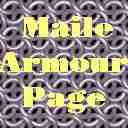
|

|
Last Revised 3 February 2008
I have had a number of requests for information on how to make rings that can be used for making maile armour. I started out with a very simple (and very inefficient!) method, but one that I will nonetheless state, as it is a way to at least get started.
I started out using a metal rod that was the diameter of the ring I wanted to create. I used a piece of rod that was approximately 20 cm (9") in length. I then cut a certain length of wire, held it fast to the rod with a pair of vice grips, and started wrapping the wire in tight circles around the rod.
Though this method has the benefit of simplicity and portability, it has a number of disadvantages. One of the main disadvantages is that the method is very tough on the hands. Holding on to the setup while tightly wrapping the wire takes a great deal of hand stamina, at least with the gauges of wire that I use. As a result, the number of coils I could make at a sitting was limited. An addition to this disadvantage, I would inevitably end up throwing out small portions of many coils because they were uneven, out of round, or otherwise warped in some way or another.
Then unto my hands came a savior! Design plans for a ring maker! The design plans I found were well done and specific, but at the time I was living in a small town in the middle of nowhere, so wanted to try to make due with what I had. I was able to make a single device that allows me to make rings of different sizes using rather common hardware:
As you can see, it is a pretty light list of items. Now I'll go through the manufacturing process. Keep in mind that my ring maker handles two rod sizes. If you only deal with one ring size (rod size) you can do with only one set of brackets.
Here are some pics of my completed ring maker. As you can see, it is crude, but it is effective!

|

|
Now that you have made your ring maker, you are ready to go! I have recently come up with a new method of coiling wire using the ring maker that has cut my time to make rings by at least 75%. Cut approximately 4 m. (13 ft.) of wire off of the spool, and loop one end around a 10 lb (4 kg) weight placed 4 meters away from where you are working. Insert the other end of the wire into the hole that is drilled in the rod. Insert the wire just enough so that it holds so as to make the wire easier to extract from the hole once the coil is completed.
Then it is simply a matter of turning the handle and dragging the weight towards you, using your other hand to guide the wire in tight circles around the rod. It is important to keep the coil tight as it ensures that all of your rings are the same size. Once you have pulled the weight up to your lap, disconnect it and wrap the remainder of the wire by using your second hand to create tension on the wire. Once all of the wire is wrapped around the rod, take a pair of needlenose pliers to remove the beginning of the wire from the hole in the rod. Then simply pull the rod out of the hole and slide the coil off of the rod. You now have a coil that should contain roughly 100 rings (depending on your ring size).
If you don't want to use the weight method, you can use your hand to create the "tension" that will keep the wire wrapping tightly around the dowel. I use my the friction of the wire on my thumb to create the tension that keeps the wire spooling closely around the dowel. Think of it as continually pressing in on the wire below the dowel to bend it around. I do not wear gloves, because they do not create enough friction for my method towork. My method is hard on the hands to begin with, but I can produce highly accurate rings rather quickly without the use of machinery.
Another thing I do on occasion to even out any uneven rings (like small bulges in a coil) is to take a pair of pliers with VERY dull teeth and tighten the coil while it is still on the dowel. This needs to be done directly on and around the portion of the coil that is uneven.
A couple of notes . . . I wrap my coils from right to left, which I have found makes linking the rings together easier. I also pull my coils apart before cutting the rings. This is easier than cutting the rings, and having to use pliers to make a large enough gap in the rings to link rings together. Just be careful not to make too large of a gap between each individual coil, as it will effect the final diameter of the ring and make your rings unevenly sized. The coil won't spread apart evenly, so you may have to do an initial stretch, then focus on places where the coils didn't separate. You only want to spread the coils enough so that there is slightly more than a wires thickness between the individual coils.
Your final step is merely to cut the rings off of the coil in a straight line down the coil. One word of caution here: depending on what you use to cut the rings, there will be a tendency for the cut to wander one direction or another. For example your second cut may drift a bit to the right of your first cut. The third cut may drift a little bit to the right of the second cut, and so on. What this effectively does is either increase or decrease the size of your rings, which is undesireable. You can monitor and compensate for this effect by using the other end of the wire as a reference point. If you notice the other end of the wire starting to rotate around the long axis of the coil, compensate accordingly with the location of your cuts.
This idea comes from Christian:
"Forgive me if you have heard this advise before... I was reading your section on your procedure for winding rings and I think your device for making rings is perfect. I use something very similar myself. There is however one way you could improve on it. Instead of inserting the end of your wire through a small hole in the rod, take the wire (I think you use about 13 feet at a time) and fold it in half. You now have a U shape. Now take a nail and insert it through the hole in your rod in such a way that you can hook the U of wire over the nail. This will secure the wire to the rod so you can begin turning it. When it is turned remove the nail and the coil slides right off the end. Now for the good part, when you cut the rings off the coil they are perfectly spaced so they can be easily formed to finished rings. In your case you can cut the U and un twist the coil into two allowing for the spacing you need to cut them apart with pliers.
"Now it is a little harder to turn the wire this way and I myself have only done it with 16ga but it is much faster and easier that turning a single wrap at a time. Plus you have the added advantage of not having to do extra work after the fact by spacing the coil. I think that the only way you can improve on this system is to use a lathe and unfortunately I do not have one.
"I have turned may rings this way and I have never had trouble with it. Please give it a try and you will see what I mean."
COMMENT: I tried Christian's method and it does work, but I have found that I can create rings faster by wraping a single wire and stretching the coil out before cutting (I may be simply set in my ways). My method doesn't create the nice, even spacing that Christian's method does though. I would recommend trying both methods and see what works best for you.
A couple of people have contacted me to let me know that they use a drill (and a friend) to make rings. The basic procedure is to attach the wire to your dowel or rod, and have a friend run the drill while you guide the wire to make the coil. I haven't tried this method, but it sounds like it would work quite well, especially if you have a drill that has a low speed (high torque) setting. I guess the only drawback to this method is that you might have to help your friend move in return for the favor!
Happy armouring!
![[To maile armour links page]](maile-links.jpg)
|

|
![[To Medieval Period Page]](../to-medieval.jpg)
|

|
![[To The Beckoning]](../../beckoning.jpg)
|